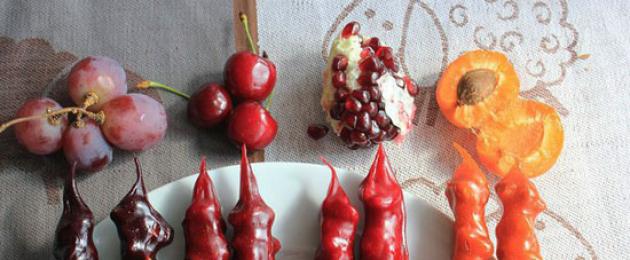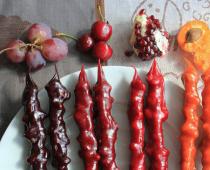The most famous Georgian sweet - churchkhela - is traditionally prepared from fresh grape juice and nuts. There is nothing difficult in making it! Nuts can be taken in one variety or assorted: choose hazelnuts, walnuts or almonds. Also for making churchkhela you will need a thick cotton thread and a large "gypsy" needle.
| Name: | Churchkhela | |
| Date added: | 09.01.2016 | |
| Cooking time: | 3 hours | |
| Servings Per Recipe: | 6 | |
| Rating: | (1
, cf. 5.00
out of 5) |
Churchkhela recipe
Wash the grapes and squeeze the juice out of it (2 liters are required). If the juice is not sweet enough, you can add sugar or honey. Take a saucepan, pour 1 liter of juice into it. Bring it to a boil, reduce heat and simmer for 10-15 minutes. Pour flour into the remaining 1 liter of juice, stirring vigorously so that no lumps form.
Instead of corn flour, you can use wheat flour, but in the classic recipe, only corn flour is used. Then pour the flour mixture into the boiling juice in a thin stream, stirring constantly. After the two types of juice have mixed, you need to let the mixture boil for 15-20 minutes to form grape jelly - pelamushi. The mixture should be constantly stirred.
For each churchkhela, measure 35-40 cm of thread on the basis that 25 cm of them will be in the sweetness itself, and the remaining 10-15 cm will go to the loop, from which the churchkhela should be hung. Find a place where the blanks will hang. On a thick and strong thread, you need to string nuts, then dip each thread well in jelly so that the nuts are covered with it from all sides.  By choosing unusual ingredients for the mixture, you will get a very special churchkhela! Hang the finished threads to dry for 20 minutes, placing food foil or baking paper under them, where the jelly will drop. Be careful not to hang the sweets too close or they will stick together! After 20 minutes, you need to repeat the dipping of each thread and again hang to dry. Repeat until the churchkhela becomes the desired thickness.
By choosing unusual ingredients for the mixture, you will get a very special churchkhela! Hang the finished threads to dry for 20 minutes, placing food foil or baking paper under them, where the jelly will drop. Be careful not to hang the sweets too close or they will stick together! After 20 minutes, you need to repeat the dipping of each thread and again hang to dry. Repeat until the churchkhela becomes the desired thickness.
Then hang the threads in a place protected from direct sunlight and leave there until final hardening (for 5-7 days). Sometimes raisins, dried fruits and seeds are added to churchkhela along with nuts. Churchkhela is also made from apple, apricot, pear and peach juices.
The daughter recently announced that she had never eaten anything tastier than Snickers. ((Well, how to understand this? ((Our grapes are now cheap, our nuts ... I decided to make her "Snickers", but only Georgian - a natural, tasty and nutritious delicacy. Shl. Georgian girls (well, boys), correct if it didn't work out quite authentic. But I tried ...
Ingredients for Churchkhela:
Churchkhela recipe:

I took Isabella grapes for juice, it is very aromatic, sweet and the juice from it is very dark in color. The easiest way to get juice from grapes, of course, is through a juicer. But I don't have such a miracle of technology, so I just punched the berries in a blender and strained them, grinding them through a sieve. If it's really tight with grapes (we have a season, I paid 100 rubles for three kilograms), take ready-made, packaged juice, but the taste, of course, will be completely different. From three kg of grape juice, I got almost 2 liters.

Prepare your nuts. I have a mix of walnuts and hazelnuts. Break them into halves or quarters, but not smaller, otherwise you will not be able to string them on a string. Leave the hazelnuts intact. Using a fairly dense, strong thread and a needle, make these walnut beads.

Pour about a glass of juice, put the rest on the stove and bring to a boil. Cook for five minutes. Add flour to a glass to juice and pour into boiling juice, stirring vigorously. I didn’t add sugar - the grapes were very sweet, but try it, you may have to sweeten it. About flour. I have seen a different ratio of flour-juice proportions. For myself, I stopped at this option - I did not add all the flour, cook it, stir it and look at the density of the resulting mass. It should be quite thick and stringy. I dipped the edge of the thread with nuts and looked to see if the mass was holding on to the nuts, if it was not draining too quickly. The amount of flour may need to be increased or, conversely, reduced. This viscous and aromatic mass must be boiled for another 5 minutes.

Well, now - the most pleasant thing. We dip the threads with the strung nuts in the syrup, melting them with a spoon. We raise it over the pan, wait a little for the excess weight of the glass and hang it in a pre-prepared place (I hung it on the open door of the oven on hooks made of paper clips. You can adapt an ordinary clothes hanger for this case). Be sure to place a baking sheet under the churchkhela or lay baking paper!

This procedure will have to be repeated several times, increasing the grape layer. When you dip the last thread, the first one will drain slightly and harden, you can wait a couple of minutes and start the process over again: dipped it, raised it, slightly glass, hung it up. I did it three times. If grape juice remains, add substandard nuts made from small pieces of nuts and place in candy tins.
Churchkhela is a natural oriental sweet made from grape juice and nuts. Churchkhela is a traditional dish in Armenia, Georgia and Azerbaijan, but you can taste it not only in the Caucasus: everywhere churchkhela is sold in the resorts of the Krasnodar Territory, as well as in many other cities of Russia. From this article you can find out what churchkhela is and how to prepare it.
What is churchkhela?
Churchkhela is a long thin sausage made from thick frozen juice. Churchkhela has nuts inside, strung on a thin thread. Walnuts are commonly used, although other options are possible. Churchkhela is traditionally made from grape juice - in this case, it turns out to be dark brown. However, now, for a more attractive appearance, churchkhela are also made from juices of other fruits.
Churchkhela is an excellent dessert for those who follow the figure, because it is completely natural: juice and nuts are quite a dietary delicacy. In addition, nuts provide a lot of energy, so churchkhela is great for a quick snack throughout the day.
What is churchkhela?
Now churchkhela is prepared not only from grape juice. There are also other varieties. The colors are brighter and more attractive with the juice of other fruits, and the taste is also different. The following types of churchkhela are now popular:
- The pomegranate churchkhela has a bright red color.
- Churchkhela with apple juice has a light amber color, sometimes with a green tint.
- Apricot churchkhela has a rich orange color.
- Classic grape churchkhela of light chocolate color.
Nowadays, more and more non-standard churchkhela variants often appear. It uses a variety of nuts: cashews, almonds, peanuts or Brazil nuts, and also adds candied fruits and dried fruits. Sometimes you can even find churchkhela of bright unnatural colors with the addition of dyes, but such a traditionally Caucasian sweetness is not and is not as useful as a natural product.


How is churchkhela prepared?
Churchkhela preparation is a rather lengthy and laborious process. Nevertheless, it can be prepared even at home, the main thing is to be patient. Consider the step-by-step instructions for making a national Caucasian dish - a classic churchkhela with grape juice and walnuts.
So, in order to prepare this delicacy, you need to have the following products on hand:
- grape juice (2 l)
- walnuts (200 g)
- sifted wheat flour (200 g)
- sugar (100 g)


With these four ingredients in total, you will make churchkhela. Use a simple step-by-step guide:
- First, you need to lightly fry the nuts over low heat, so that it is easier to separate them from the skin. Make sure you peel all the nuts well, as the peel will get stuck in your teeth and make the sweetness uneven.
- Large pieces of nuts are suitable - it is better to take whole or halved. With the help of a needle, they should be carefully strung on a thread. Tie a match to the bottom end of the thread. Make about 20-30 cm of nuts per thread, and then tie the thread into a loop on top.
- Grape juice should be simmered in a metal bowl. In total, you need to cook for about two hours, periodically removing the foam.
- Then gradually pour the sugar into the juice, stirring it so that the sugar is evenly distributed.
- Let the juice cool to room temperature.
- Gradually pour the flour into it, stirring the substance, so that no lumps form. The texture of your mixture, which Caucasians call Tatar) should be uniform.
- Put the container back on to simmer. Wait until the volume is reduced by half and the mixture is thick enough.
- You need to dip a bunch of nuts into a hot thick mass, wait 5-7 minutes until it dries, and dip it two or three more times with the same interval.
- Do the same for each bunch of nuts.
- Then the churchkhela must be dried in the sun. It should stop sticking to your hands.
- Wrap the churchkhela in a towel and leave in a dry, ventilated place to ripen for a couple of months. After ripening, the churchkhela will be covered with a film of powdered sugar - this is a normal process. At the same time, it should remain the same soft.


Natural churchkhela is a tasty and healthy sweetness that you can not only buy ready-made, but also easily make at home yourself. Churchkhela can be a delicious and healthy dessert for those who follow the figure. It is also perfect as an addition to a hearty breakfast or a snack on the road, because nuts give a boost of vivacity, and juice nourishes the body with vitamins.
Those who visit the south of our country for the first time in their lives, in particular, look with great bewilderment at the small multi-colored sausages sold in bazaars and beaches. They are especially surprised by their unusual name - churchkhela. What it is, and how it is being prepared, we will try to find out now.
This is a national delicacy of oriental cuisine. Despite the fact that it is widespread in Armenia, Georgia, Azerbaijan and Greece, Georgians consider churchkhela to be their original "invention", and even filed a patent for it. Now, along with khachapuri, chacha and suluguni, churchkhela is also a Georgian brand.
Hazelnut low, covered with dried boiled fruit juice. As the legends say, this delicacy appeared in ancient times, when warriors, going on campaigns, took with them tasty and nutritious sausages that did not require hassle in preparation and perfectly restoring strength. Since they often had to fight, they prepared churchkhela for future use, not fearing that it would deteriorate. It will definitely last a year, and from the next harvest you can make new delicious sausages with nuts called churchkhela. What it is - you already have an idea. Now let's talk about how it is prepared.

How to cook churchkhela at home
To prepare this product, you will need to stock up on nuts, grape juice, sugar, flour, and harsh cotton thread with a needle. You can take any nuts, although walnuts are traditionally used and strung on a thread whole, and the walnut kernels are divided into two halves. The optimal length of the nut low is about 30 cm. This is just enough for a thick broth of juice, called Tatara, to cover it with a dense layer. And it is best to select the length of the thread depending on the depth of the pan in which the syrup will be boiled. The dependence here is such - a low one should completely immerse in the Tatara without bends and kinks.
After all the nuts are tightly strung, you can start cooking Tatars. Three liters of freshly squeezed grape juice is poured into a saucepan (it is advisable not to use an enamel one), a glass of sugar is added to it, all this is put on a small fire. You need to cook the juice with constant stirring until its volume is reduced by half. Do not forget that the foam formed during the cooking process must be removed. The result is what the Georgians call badagi.

Pour about a couple of glasses of badagi into a wide bowl and cool the contents. We dilute two glasses of flour in cooled syrup, carefully breaking the resulting lumps. To ensure the homogeneity of the mass, it can be rubbed at the end through a sieve. We combine both parts of the juice and again send it to the fire. Do not leave the stove. You must constantly stir the mass, otherwise it will burn. After the contents of the pan thicken and acquire a shine, you can turn off the heat and consider the process of cooking tartars finished.
After letting it cool slightly, take the walnut bottom and dip it entirely into the hot mass. After waiting for about 20 seconds, take out the thread, let the last drops drain, and send it to dry. After two hours, we repeat the entire sequence of actions. Ideally, the layer of the Tatars should reach one and a half centimeters.
Since it will take a long time to make churchkhela in this way, you can slightly reduce the total preparation time for the delicacy by tying several threads with nuts to the rail at once and dipping them into the tatar at the same time. After you find that the thickness of the layer suits you, send the semi-finished churchkhela for a couple of weeks in the sun to dry. The readiness can be judged by touch - if it does not stick to your hands, then drying can be considered complete. Now you need to wrap the sausages in a cloth and leave to ripen. In a month, you can treat your admired loved ones with a delicacy called churchkhela.
You now know what it is and, as a true culinary expert, you can start experimenting by changing the varieties of nuts and fruit juices. And you can also do without thread, simply by mixing the finished tartara with nuts. It will, of course, not be a churchkhela in the classical sense, but no less tasty treat.
There are few tasty and healthy desserts that can retain their taste for months. Churchkhela or " sudjuk from walnuts "contains ingredients available almost at any time of the year, can compete with other recipes in ease of manufacture. A centuries-old curiosity from the east was often used by warriors on long campaigns to reinforce their forces. It is an integral part of local feasts and feasts.
How to make churchkhela - essential ingredients
- Fresh grapes - 1.5 - 3 kg. Sweet varieties with the least seed content are suitable, such as Isabella, Moldova out of season, you can use store or homemade canned juice 1 - 2 liters.
- Nuts - in the classic version, walnuts and hazelnuts are used, there are different ratios, for example, 70% to 30%, nothing interferes with changing the proportions. The total weight is 150 - 200 g per liter of juice.
- Wheat or sifted corn flour - 100 - 125 g per 1 liter of juice.
- A thick needle and a few meters of strong cotton thread, a thimble.
How to make churchkhela - cooking
Nuts
- If you want to move away from the canonical recipe, you can add pumpkin seeds, raisins, apricot kernels or small prunes to the nuts. Also, pomegranate juice will give the candy a red color, apple juice - amber, apricot juice - yellow.
- The cooking process itself begins with the preparation of a place for drying churchkhela. The average length of the threads is 30 - 40 cm. Do not forget that the juice will drip at first, so baking paper or baking trays are prepared so as not to spoil the lower surfaces. If it is located outdoors, you will need gauze covers to protect it from insects.
- The next step begins with lightly roasting the nuts in an empty pan for 3-5 minutes. The walnut is divided into halves and if it is very large, then into quarters.
- Now you need to string the nuts on a thread, piercing them with a needle, a row 15-25 cm long is created.An indent is also left from each edge of the sausage of 5-10 cm.A knot is tied from one edge or a toothpick is tied so that the nuts do not slide out. On the other, there is a loop for fastening threads in a vertical position.


Cooking pelamushi
- The grapes are washed, put in a juicer. If this technique is not available, a blender will come in handy, after which the pulp is wiped through a sieve or squeezed through cheesecloth. All the juice, except for 200 - 300 g of a glass, is poured into a saucepan and cooked over low heat for 15-25 minutes. The remaining portion goes into the dishes along with the flour, mixes until a homogeneous consistency.
- After the juice has boiled, you can cook for a couple of minutes. The contents of the liquid with flour are added in a small stream, not forgetting to stir actively with a wooden spoon. There is no need to rush, this is one of the most important stages. Rushing or not stirring will result in lumps, which can be detrimental to the result.
- The juice is boiled for 15 - 20 minutes. to a jelly-like state. Stirred every couple of minutes. It is also worth trying the juice for sweetness, if it is sour, add honey or sugar. If the juice thickens enough and sticks to the spoon, then it is cooled on the stove to 50 ° C.


Churchkhela - the final stage
- Prepared threads with nuts are dipped in pelamush with a spoon for 3-5 minutes. This is done so that the ends of the threads do not fall into the dishes. The sweets are kept over a saucepan to drain the excess. If the nuts are completely bare, then the jelly was not thick enough and the next time you need to add flour. Then the sweets are hung out to dry for 20 minutes. The procedure is repeated until the nuts are covered by 2 cm (or slightly more) pelamushi.
- The remnants of jelly and nuts can be mixed, and then poured into small forms and put in the oven for 10-20 minutes. Delicious sweets will turn out. The very same pelamush in the apartment it will dry for 4-7 days. You can speed up the process and expose it to the sun for 2 days, but this will dry out the product more.
- Churchkhel is practically ready for use. According to tradition, they are laid out in boxes and hidden in dark, dry places for several months for the final impregnation of the nuts.


As you can see from the example above, Oriental curiosities are not always difficult to prepare, or not available in terms of ingredients. But they certainly greatly diversify the dessert line in everyday life. Also in the future, you can experiment with filling and spices, which will finally add uniqueness to the product.
- In contact with 0
- Google+ 0
- OK 0
- Facebook 0







